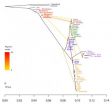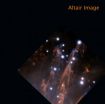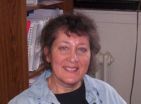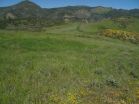(Press-News.org) When Charles Darwin first sketched how species evolved by natural selection, he drew what looked like a tree. The diagram started at a central point with a common ancestor, then the lines spread apart as organisms evolved and separated into distinct species.
In the 175 years since, scientists have come to agree that Darwin's original drawing is a bit simplistic, given that multiple species mix and interbreed in ways he didn't consider possible (though you can't fault the guy for not getting the most important scientific theory of all time exactly right the first time). Using a tree-like structure is a great way to show the history of the evolution of a species, or its phylogeny. But it's not so great for showing the population history of groups within a single species, such as humans, who can move around and interbreed with each other.
Jonathan Pritchard, PhD, professor in the department of human genetics, studies the nature of these human genetic variations by combining methods from evolutionary biology and statistics. Intrigued by recent research on the Neanderthal genome that suggests more interbreeding with Homo sapiens than previously thought, Pritchard wanted to develop a general method for estimating gene flow between different groups within the same species over time. In a recent paper published in PLOS Genetics, he and Joseph Pickrell, a former University of Chicago researcher now at Harvard, described a software model they developed that can infer the history of population splits and mixtures within a species based on modern DNA.
"If you try to make a tree of population histories within a species, there's always the possibility that you've got genes flowing from one branch to another," Pritchard said. "The populations can interbreed, so if they're geographically together or if there's movement from one place to another, then this tree representation is not necessarily going to be a good way of representing history. The goal of this research is to learn more about departures from 'tree-ness.'"
Pritchard and Pickrell developed software called TreeMix that compares how often variants of a particular gene from different populations appear in the same species. It then calculates how closely groups are related, and when in their history they separated to form a genetically distinct population or breed.
The resulting graph looks less like tree branches and more like a tangled shrub or mass of vines. The trunk of the shrub represents the major relationships between the groups, and the largest branches represent distinct populations as they develop over time from left to right on the graph. But those tangled vines that crisscross the branches are the key, showing migration events where a previously separate population mixed with another, rejoining to form a new group at a later point in time.
Pritchard and Pickrell tested the model using DNA from 55 human populations and 82 dog breeds, and already found some interesting results. For example, boxer and basenji breeds of dogs trace a large portion of their DNA (nine percent and 25 percent, respectively) back to wolves after domestication, meaning that these breeds interbred with wolves again after humans had begun to domesticate dogs.
"What I like about this is that it's starting to give us some resolution on relationships that are just much more complicated than you can capture using the standard tree approach," Pritchard said.
He gave another example of the Mozabite people who live in Algeria. Their DNA is largely a mixture of European and Middle Eastern ancestry, but they also mixed with sub-Saharan African ancestors at various points in their history. The new model can represent the complex relationships among all of these backgrounds, whereas the traditional tree-based method would just show a primary relationship to Middle Easterners.
Another group of researchers has already used Pritchard's software to show a link between Denisovans, an extinct relative of Neanderthals found in Siberia, and Papuans in the South Pacific. It doesn't make geographic sense right away, but such a finding forces researchers to ask more questions about how these groups migrated and changed over time. Much like DNA evidence has revolutionized criminal investigations, often negating assumptions based on physical evidence, advanced genetic analysis like Pritchard's can change what we think about human history as well.
INFORMATION:
About the University of Chicago Medicine
The University of Chicago Medicine and its Comer Children's Hospital rank among the best in the country, most notably for cancer treatment, according to U.S. News & World Report's survey of the nation's hospitals. The University of Chicago's Pritzker School of Medicine has been named one of the Top 10 medical schools in the nation, by U.S. News' "Best Graduate Schools" survey. University of Chicago physician-scientists performed the first organ transplant and the first bone marrow transplant in animal models, the first successful living-donor liver transplant, the first hormone therapy for cancer and the first successful application of cancer chemotherapy. Its researchers discovered REM sleep and were the first to describe several of the sleep stages. Twelve of the Nobel Prize winners have been affiliated with the University of Chicago Medicine.
Visit our research blog at sciencelife.uchospitals.edu and our newsroom at uchospitals.edu/news.
Twitter @UChicagoMed
Facebook.com/UChicagoMed
A history lesson from genes
Using DNA to tell us how populations change
2013-01-10
ELSE PRESS RELEASES FROM THIS DATE:
Study examines how news spreads on Twitter
2013-01-10
Nearly every major news organization has a Twitter account these days, but just how effective is the microblogging website at spreading news? That's the question University of Arizona professor Sudha Ram set out to answer in a recent study of a dozen major news organizations that use the social media website as one tool for sharing their content.
The answer, according to Ram's research, varies widely by news agency, and there may not be one universally applicable strategy for maximizing Twitter effectiveness. However, news agencies can learn a lot by looking at how their ...
Unnecessary antimicrobial use increases risk of recurrent infectious diarrhea
2013-01-10
The impact of antibiotic misuse has far-reaching consequences in healthcare, including reduced efficacy of the drugs, increased prevalence of drug-resistant organisms, and increased risk of deadly infections. A new study featured in the February issue of Infection Control and Hospital Epidemiology, the journal of the Society for Healthcare Epidemiology of America, found that many patients with Clostridium difficile infection (C. difficile) are prescribed unnecessary antibiotics, increasing their risk of recurrence of the deadly infection. The retrospective report shows ...
Flooding preparedness needs to include infection prevention and control strategies
2013-01-10
Flooding can cause clinical and economic damage to a healthcare facility, but reopening a facility after extensive flooding requires infection prevention and control preparedness plans to ensure a safe environment for patients and healthcare workers. In a study published in the February issue of Infection Control and Hospital Epidemiology, the journal of the Society for Healthcare Epidemiology of America, clinical investigators report key findings and recommendations related to the closure and re-opening of hospitals impacted by black-water floods. The guidance builds on ...
Faulty behavior
2013-01-10
PASADENA, Calif.—In an earthquake, ground motion is the result of waves emitted when the two sides of a fault move—or slip—rapidly past each other, with an average relative speed of about three feet per second. Not all fault segments move so quickly, however—some slip slowly, through a process called creep, and are considered to be "stable," or not capable of hosting rapid earthquake-producing slip. One common hypothesis suggests that such creeping fault behavior is persistent over time, with currently stable segments acting as barriers to fast-slipping, shake-producing ...
Next-generation adaptive optics brings remarkable details to light in stellar nursery
2013-01-10
A new image released today reveals how Gemini Observatory's most advanced adaptive optics (AO) system will help astronomers study the universe with an unprecedented level of clarity and detail by removing distortions due to the Earth's atmosphere. The photo, featuring an area on the outskirts of the famous Orion Nebula, illustrates the instrument's significant advancements over previous-generation AO systems.
"The combination of a constellation of five laser guide stars with multiple deformable mirrors allows us to expand significantly on what has previously been possible ...
Microscopic blood in urine unreliable indicator of urinary tract cancer
2013-01-10
Rochester, MN, January 9, 2013 – Microscopic amounts of blood in urine have been considered a risk factor for urinary tract malignant tumors. However, only a small proportion of patients referred for investigation are subsequently found to have cancer. A new Kaiser Permanente Southern California study published in the February Mayo Clinic Proceedings reports on the development and testing of a Hematuria Risk Index to predict cancer risk. This could potentially lead to significant reductions in the number of unnecessary evaluations.
Individuals with microscopic hematuria ...
Small price differences can make options seem more similar, easing our buying decisions
2013-01-10
Some retailers, such as Apple's iTunes, are known for using uniform pricing in an effort to simplify consumers' choices and perhaps increase their tendency to make impulse purchases. But other stores, like supermarkets, often have small price differences across product flavors and brands.
As counterintuitive as it might seem, these small price differences may actually make the options seem more similar, according to new research published in Psychological Science, a journal of the Association for Psychological Science. The research shows that adding small differences ...
Online message boards provide outlets for mothers' concerns, MU researcher says
2013-01-10
COLUMBIA, Mo. –Parenting infants and toddlers can be challenging, and for generations, mothers have turned to other moms for advice. Now, with the availability of the Internet, mothers are consulting each other using modern venues: online message boards. Research from the University of Missouri indicates online discussion boards provide safe environments for mothers to anonymously express child-rearing concerns and receive support from other moms.
"Mothers have feelings that they might be embarrassed to talk about face-to-face with someone," said Jean Ispa, professor ...
Invading species can extinguish native plants despite recent reports
2013-01-10
TORONTO, ON – Ecologists at the University of Toronto and the Swiss Federal Institute of Technology Zurich (ETH Zurich) have found that, given time, invading exotic plants will likely eliminate native plants growing in the wild despite recent reports to the contrary.
A study published in Proceedings of the National Academy of Sciences (PNAS) reports that recent statements that invasive plants are not problematic are often based on incomplete information, with insufficient time having passed to observe the full effect of invasions on native biodiversity.
"The impacts ...
Engineering alternative fuel with cyanobacteria
2013-01-10
ALBUQUERQUE, N.M. — Sandia National Laboratories Truman Fellow Anne Ruffing has engineered two strains of cyanobacteria to produce free fatty acids, a precursor to liquid fuels, but she has also found that the process cuts the bacteria's production potential.
Micro-algal fuels might be one way to reduce the nation's dependence on foreign energy. Such fuels would be renewable since they are powered by sunlight. They also could reduce carbon dioxide emissions since they use photosynthesis, and they could create jobs in a new industry. President Barack Obama, speaking in ...
LAST 30 PRESS RELEASES:
This new understanding of T cell receptors may improve cancer immunotherapies
A new fossil face sheds light on early migrations of ancient human ancestor
A new immunotherapy approach could work for many types of cancer
A new way to diagnose deadly lung infections and save lives
40 percent of MRI signals do not correspond to actual brain activity
How brain-inspired algorithms could drive down AI energy costs
Gum disease may be linked to plaque buildup in arteries, higher risk of major CVD events
Contrails are a major driver of aviation’s climate impact
Structure of dopamine-releasing neurons relates to the type of circuits they form for smell-processing
Reducing social isolation protects the brain in later life
Keeping the heart healthy increases longevity even after cancer
Young adults commonly mix cannabis with nicotine and tobacco
Comprehensive review illuminates tau protein's dual nature in brain health, disease, and emerging psychiatric connections
Book prepares K-12 leaders for the next public health crisis
Storms in the Southern Ocean mitigates global warming
Seals on the move: Research reveals key data for offshore development and international ecology
Sports injuries sustained during your period might be more severe
World's first successful 2 Tbit/s free-space optical communication using small optical terminals mountable on satellites and HAPS
Can intimate relationships affect your heart? New study says ‘yes’
Scalable and healable gradient textiles for multi‑scenario radiative cooling via bicomponent blow spinning
Research shows informed traders never let a good climate crisis go to waste
Intelligent XGBoost framework enhances asphalt pavement skid resistance assessment
Dual-function biomaterials for postoperative osteosarcoma: Tumor suppression and bone regeneration
New framework reveals where transport emissions concentrate in Singapore
NTP-enhanced lattice oxygen activation in Ce-Co catalysts for low-temperature soot combustion
Synergistic interface engineering in Cu-Zn-Ce catalysts for efficient CO2 hydrogenation to methanol
COVID-19 leaves a lasting mark on the human brain
Scientists use ultrasound to soften and treat cancer tumors without damaging healthy tissue
Community swimming program for Black youth boosts skills, sense of belonging, study finds
Specific depressive symptoms in midlife linked to increased dementia risk
[Press-News.org] A history lesson from genesUsing DNA to tell us how populations change




